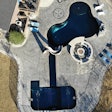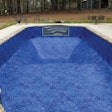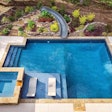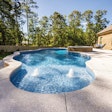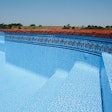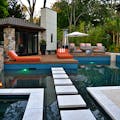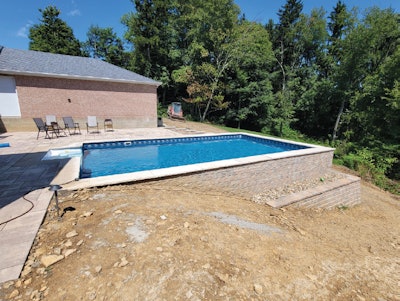
Pittsburgh is a river town, as the Allegheny and the Menongahela and all their tributaries slice through western Pennsylvania on their way to meet the mighty Ohio river, headed west. What they leave behind is a lot of dramatic backyard dropoffs.
Strangely enough, these sloping properties offer builders the opportunity to build some great pools at affordable prices. Yes, the steep grade, semi-inground pools are a little harder to support on the underside, that takes a little extra work, but they offer significant upside because unlike an inground pool in say, Kansas or Florida, they come with a built-in view as the ground falls away from the homeowners back deck.
Witness this elegant vinyl-liner pool built on a steep slope in the greater Pittsburgh area with a lovely view stretching away from the deck slider for just north of $45,000. Tyler Haas, manager at Alpine Pools, does a fair number of such pools and understands the economics of semiinground construction. This is the company's 60th year in the business, so they have considerable experience with the engineering challenge of building on an incline.
"We have tons of people who live on hills and slopes," he says. "On this job specifically (see photos on page 71), because there was such a steep slope, we couldn't even put the pool on the ground to begin with. Instead, we had to carve out some space. We worked with an awesome landscaping company called Raintree to do that.

"Before we even began, they had to start to come out and build a 1 1/2-foot retaining wall that you can see on the lower half of the hill, just to give us ground to put the pool on. And then, once we had the pool in, Raintree built the wall on the side of the pool using the same material to tie it all together."
On a pool with a firm budget, he adds, aspects of the project that can save money and add value are important. "For instance, with this Latham Radiant pool, you can just concrete right up to it, which is great. It also has an aluminum wall and 2 inches of insulation, which keeps it 7 to 10 degrees warmer.
"Typically, inground pools don't have that — they're either steel or plastic with no insulation, and they can only be installed on the ground with no dirt up against the pool wall. To use that pool on this type of slope, people would have to cut the hillside further back and create more of a gap and meet township codes, which adds cost.
"This pool eliminates that because you can just build right up to it. We used a retaining wall on this pool, but in some cases, it can save the expense of a retaining wall because you can backfill right up against the pool, and it acts as the barrier, which is important for people who are on the fence thinking about an aboveground pool, because they usually have a different type of budget.
"The insulation also helps because most swimming pools lose a lot of heat through the walls, which are either exposed as in the case of an aboveground, or an inground just has gravel and dirt behind it. So now, just like your house, even if you just use a solar cover, you've got the walls and roof insulated, and that is so much better for retaining heat."

JUST A WEEK TO BUILD, TYPICALLY
Builders and customers love vinyl pools for a variety of reasons — affordable price, low maintenance, and rapid renovations down the line — but the speed with which they can be built is particularly endearing. Builders want to keep a tight schedule, and homeowners want their backyard back.
On this particular job, the weather was beautiful, the kind that makes building a pleasure, and the pool was done in the allotted seven days without a hitch.
"That's typical for us," Haas says. "Usually, we will dig on day one and get the dirt placed properly at the homeowner's direction. Then, if the weather is good the next day, as it was in this case, day two and three is construction of the pool walls and braces. Then we're stabilizing the pool to manufacturer specifications, which is pouring the concrete bond beam around the whole pool just to secure it. Then comes the running of the plumbing, the equipment, getting everything installed there. And lastly, we do a concrete/vermiculite hard bottom, put the liner in and start filling."
"Radiant insulated panels are so versatile for inground or semi-inground pools for backyards with challenging elevations, they offer builders and homeowners total flexibility and lasting durability," adds Colin Sirco, vice president for operations, Radiant Pools.
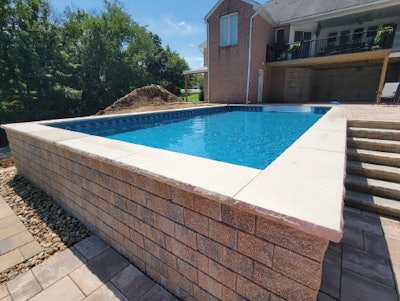
FINISHING TOUCHES
On a pool like this, the final touches and subtle features are what make it a beloved space for the customer, such as the bar-top coping treatment which invites bathers to belly up and rest their elbows for a conversation.
"The inground walk-in steps, too, are a really cool feature because when you're walking out your door, you see an inground pool right in front of you, and you can just walk right into it, whereas without them, you have ladders to deal with or something that takes up swimming space. So you put these 4-by-8 exterior steps for access, and it does not complicate anything or take away from swimming space. They also added a hot tub from us as well, down on the lower slope to the right side of the pool," Haas says.
"So they really created a lot of usable space on their property. Otherwise, they just had a grassy hillside. But now, they have an area with a hydrotherapy spa, a swimming pool, and they can pull up some chairs and enjoy time together in the backyard."
This article first appeared in the April 2025 issue of AQUA Magazine — the top resource for retailers, builders and service pros in the pool and spa industry. Subscriptions to the print magazine are free to all industry professionals. Click here to subscribe.


























